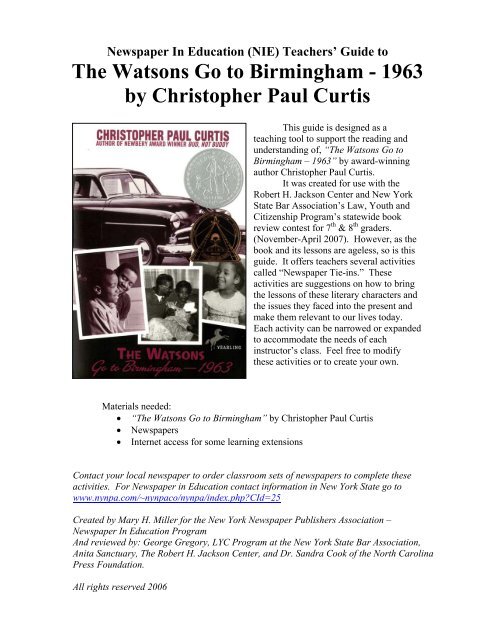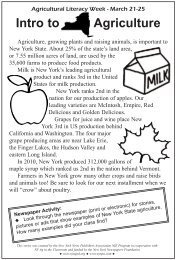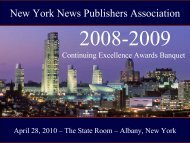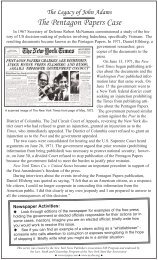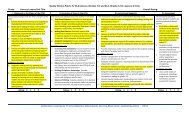The Watsons Go to Birmingham - New York News Publishers ...
The Watsons Go to Birmingham - New York News Publishers ...
The Watsons Go to Birmingham - New York News Publishers ...
You also want an ePaper? Increase the reach of your titles
YUMPU automatically turns print PDFs into web optimized ePapers that Google loves.
<strong>New</strong>spaper In Education (NIE) Teachers’ Guide <strong>to</strong><br />
<strong>The</strong> <strong>Watsons</strong> <strong>Go</strong> <strong>to</strong> <strong>Birmingham</strong> - 1963<br />
by Chris<strong>to</strong>pher Paul Curtis<br />
This guide is designed as a<br />
teaching <strong>to</strong>ol <strong>to</strong> support the reading and<br />
understanding of, “<strong>The</strong> <strong>Watsons</strong> <strong>Go</strong> <strong>to</strong><br />
<strong>Birmingham</strong> – 1963” by award-winning<br />
author Chris<strong>to</strong>pher Paul Curtis.<br />
It was created for use with the<br />
Robert H. Jackson Center and <strong>New</strong> <strong>York</strong><br />
State Bar Association’s Law, Youth and<br />
Citizenship Program’s statewide book<br />
review contest for 7 th & 8 th graders.<br />
(November-April 2007). However, as the<br />
book and its lessons are ageless, so is this<br />
guide. It offers teachers several activities<br />
called “<strong>New</strong>spaper Tie-ins.” <strong>The</strong>se<br />
activities are suggestions on how <strong>to</strong> bring<br />
the lessons of these literary characters and<br />
the issues they faced in<strong>to</strong> the present and<br />
make them relevant <strong>to</strong> our lives <strong>to</strong>day.<br />
Each activity can be narrowed or expanded<br />
<strong>to</strong> accommodate the needs of each<br />
instruc<strong>to</strong>r’s class. Feel free <strong>to</strong> modify<br />
these activities or <strong>to</strong> create your own.<br />
Materials needed:<br />
• “<strong>The</strong> <strong>Watsons</strong> <strong>Go</strong> <strong>to</strong> <strong>Birmingham</strong>” by Chris<strong>to</strong>pher Paul Curtis<br />
• <strong>New</strong>spapers<br />
• Internet access for some learning extensions<br />
Contact your local newspaper <strong>to</strong> order classroom sets of newspapers <strong>to</strong> complete these<br />
activities. For <strong>New</strong>spaper in Education contact information in <strong>New</strong> <strong>York</strong> State go <strong>to</strong><br />
www.nynpa.com/~nynpaco/nynpa/index.php?CId=25<br />
Created by Mary H. Miller for the <strong>New</strong> <strong>York</strong> <strong>New</strong>spaper <strong>Publishers</strong> Association –<br />
<strong>New</strong>spaper In Education Program<br />
And reviewed by: George Gregory, LYC Program at the <strong>New</strong> <strong>York</strong> State Bar Association,<br />
Anita Sanctuary, <strong>The</strong> Robert H. Jackson Center, and Dr. Sandra Cook of the North Carolina<br />
Press Foundation.<br />
All rights reserved 2006
<strong>New</strong> <strong>York</strong> State Standards addressed in these activities:<br />
Social Studies:<br />
• Standard 1: His<strong>to</strong>ry of the United States and <strong>New</strong> <strong>York</strong> – Students will use a variety of<br />
intellectual skills <strong>to</strong> demonstrate their understanding of major ideas, eras, themes, developments,<br />
and turning points in the his<strong>to</strong>ry of the United States and <strong>New</strong> <strong>York</strong>.<br />
• Standard 3: Geography – Students will use a variety of intellectual skills <strong>to</strong> demonstrate their<br />
understanding of the geography of the interdependent world in which we live – local, national,<br />
and global – including the distribution of people, places and environments over the Earth’s<br />
surface.<br />
English Language Arts<br />
• Standard 1: Language for Information and Understanding – Students will listen, speak, read and<br />
write for information and understanding. As listeners and readers, students will collect data,<br />
facts, and ideas; discover relationships, concepts, and generalizations; and use knowledge<br />
generated from oral, written, and electronically produced texts. As speakers and writers, they<br />
will use oral and written language that follows the accepted conventions of the English language<br />
<strong>to</strong> acquire, interpret, apply, and transmit information.<br />
• Standard 2: Language for Literacy Response and Expression – Students will read and listen <strong>to</strong><br />
oral, written, and electronically produced texts and performances from American and world<br />
literature; relate texts and performances <strong>to</strong> their own lives; and develop an understanding of the<br />
diverse social, his<strong>to</strong>rical, and cultural dimensions the texts and performances represent. As<br />
speakers and writers, students will use oral and written language for self-expression and artistic<br />
creation.<br />
• Standard 3: Language for Critical Analysis and Evaluation – Students will listen, speak, read and<br />
write for critical analysis and evaluation. As listeners and readers, students will analyze<br />
experiences, ideas, information, and issues presented by others using a variety of established<br />
criteria. As speakers and writers, they will use oral and written language that follows the<br />
accepted conventions of the English language <strong>to</strong> present, from a variety of perspectives, their<br />
opinions and judgments on experiences, ideas, information and issues.<br />
Mathematics, Science, and Technology<br />
• Standard 3: Students will understand mathematics and become mathematically confident by<br />
communicating and reasoning mathematically, by applying mathematics in real-world settings,<br />
and by solving problems through the integrated study of number systems, geometry, algebra,<br />
data analysis, probability and trigonometry.<br />
• Standard 4: Students will understand and apply scientific concepts, principles, and theories<br />
pertaining <strong>to</strong> the physical setting and living environment and recognize the his<strong>to</strong>rical<br />
development of ideas in science.<br />
Created by the <strong>New</strong> <strong>York</strong> <strong>New</strong>spaper <strong>Publishers</strong> Association – <strong>New</strong>spaper In Education. All rights reserved 2006<br />
2
Pre-reading <strong>New</strong>spaper In Education Exercise<br />
A Tale of Two Cities –<br />
Flint vs. <strong>Birmingham</strong><br />
<strong>The</strong> setting for the book “<strong>The</strong> <strong>Watsons</strong> <strong>Go</strong> <strong>to</strong> <strong>Birmingham</strong> – 1963” is divided between the Watson<br />
family’s home<strong>to</strong>wn of Flint and Grandma Sands’ home<strong>to</strong>wn of <strong>Birmingham</strong>. Before your class starts<br />
reading this book, why not have your students discover a bit more about these two locations so they<br />
can better understand the s<strong>to</strong>ry? A lot of details about any location can be discovered by reading, and<br />
studying its local, home<strong>to</strong>wn newspaper.<br />
At least 2 weeks prior <strong>to</strong> reading the s<strong>to</strong>ry have your students draft a business letter requesting a copy<br />
of <strong>The</strong> Flint Journal and <strong>The</strong> <strong>Birmingham</strong> <strong>New</strong>s. Mail these requests <strong>to</strong> the following individuals, and<br />
please include requested payment. You should be receiving classroom copies of your local newspaper<br />
<strong>to</strong> complete the remaining exercises in this guide.<br />
Flint: One edition per classroom please (not one for each child). Send $1.75 for a weekday newspaper with<br />
your request letter. Make checks payable <strong>to</strong> <strong>The</strong> Flint Journal and send <strong>to</strong>: Richard Vaughn, NIE Coordina<strong>to</strong>r,<br />
<strong>The</strong> Flint Journal, 200 East 1 st Street, Flint, MI 48502.<br />
<strong>Birmingham</strong>: One edition per classroom please (not one for each child). Send 50 cents for the newspaper with<br />
your request letter. Make checks payable <strong>to</strong> <strong>The</strong> <strong>Birmingham</strong> <strong>New</strong>s and send <strong>to</strong>: Barbara Emanuel, NIE<br />
Manager, <strong>The</strong> <strong>Birmingham</strong> <strong>New</strong>s, 2201 4th Avenue North, <strong>Birmingham</strong>, AL 35203.<br />
Materials needed:<br />
• Copies of <strong>The</strong> Flint Journal, <strong>The</strong> <strong>Birmingham</strong> <strong>New</strong>s and your local newspaper<br />
• Flint vs. <strong>Birmingham</strong> Student Worksheet<br />
General <strong>Go</strong>als:<br />
• Establish an understanding of the main settings for the s<strong>to</strong>ry.<br />
o Identify the locations of Flint, Michigan and <strong>Birmingham</strong>, Alabama.<br />
o Select and chart information from newspapers/other sources concerning each location.<br />
• Establish a connection/relationship <strong>to</strong> the s<strong>to</strong>ry by comparing and contrasting Flint and<br />
<strong>Birmingham</strong> <strong>to</strong> the students’ home<strong>to</strong>wn or city.<br />
o Begin <strong>to</strong> establish an entry for students <strong>to</strong> see themselves in the s<strong>to</strong>ry.<br />
Time required:<br />
• 2 <strong>to</strong> 3 hours of class time<br />
Created by the <strong>New</strong> <strong>York</strong> <strong>New</strong>spaper <strong>Publishers</strong> Association – <strong>New</strong>spaper In Education. All rights reserved 2006<br />
3
Student Worksheet 1<br />
A Tale of Two Cities – Flint vs. <strong>Birmingham</strong><br />
<strong>The</strong> setting for the book “<strong>The</strong> <strong>Watsons</strong> <strong>Go</strong> <strong>to</strong> <strong>Birmingham</strong> – 1963” is divided between the Watson<br />
family’s home<strong>to</strong>wn in the city of Flint and Grandma Sands’ home<strong>to</strong>wn of <strong>Birmingham</strong>. As a group,<br />
look through a newspaper from each city and fill in the chart below.<br />
Location:<br />
What state is it in?<br />
Geographic features:<br />
(ie: river, lake, hills)<br />
Climate/Weather:<br />
Average Hi/Low temp<br />
Normal Precipitation<br />
Types of Jobs:<br />
Listings in Classifieds:<br />
# of Professional<br />
# of Full-time<br />
# of part-time<br />
Housing:<br />
Average cost for home<br />
Average monthly cost<br />
of an apartment<br />
Children:<br />
Find a s<strong>to</strong>ry about<br />
children – give 3 main<br />
points of the s<strong>to</strong>ry.<br />
FLINT<br />
BIRMINGHAM<br />
Local Issues:<br />
What local issues are<br />
people most<br />
concerned about?<br />
If you need more information <strong>to</strong> complete the grid and have access <strong>to</strong> the internet, go <strong>to</strong> each<br />
newspaper’s website <strong>to</strong> do more research. For Flint go <strong>to</strong>– www.mlive.com/fljournal<br />
For <strong>Birmingham</strong> go <strong>to</strong> – www.al.com/birminghamnews<br />
On the back of this sheet or on a separate piece of paper, compare and contrast these two cities. What<br />
seems <strong>to</strong> be similar and what seems <strong>to</strong> be different?<br />
If time permits, compare these two places with your home<strong>to</strong>wn.<br />
Created by the <strong>New</strong> <strong>York</strong> <strong>New</strong>spaper <strong>Publishers</strong> Association – <strong>New</strong>spaper In Education. All rights reserved 2006<br />
4
Created by the <strong>New</strong> <strong>York</strong> <strong>New</strong>spaper <strong>Publishers</strong> Association – <strong>New</strong>spaper In Education. All rights reserved 2006<br />
5
While You Read <strong>New</strong>spaper In Education Exercise<br />
Student Worksheet 3<br />
Family Relationships – How “weird” are the <strong>Watsons</strong>?<br />
Relationships within families can be very complex. Select any two members of the Watson family and,<br />
as you read, write down their interactions, including their feelings and motivations. Plotting these key<br />
points will help you organize your thoughts <strong>to</strong> write an essay about these characters and their<br />
relationships. In the book, Kenny often refers <strong>to</strong> the Watson family as weird. <strong>The</strong> theme of the essay<br />
is Family Relationships; be sure <strong>to</strong> answer the question: Do you think the <strong>Watsons</strong> are weird?<br />
Action Character 1: Character 2:<br />
An assessment rubric is on the following page.<br />
Created by the <strong>New</strong> <strong>York</strong> <strong>New</strong>spaper <strong>Publishers</strong> Association – <strong>New</strong>spaper In Education. All rights reserved 2006<br />
6
Created by the <strong>New</strong> <strong>York</strong> <strong>New</strong>spaper <strong>Publishers</strong> Association – <strong>New</strong>spaper In Education. All rights reserved 2006<br />
7
Mini <strong>New</strong>spaper In Education Exercises by Chapter<br />
Chapter 1 – And You Wonder Why We Get Called the Weird <strong>Watsons</strong><br />
• <strong>The</strong> s<strong>to</strong>ry begins with the Watson family trying <strong>to</strong> keep warm on a severely cold winter day.<br />
Using the newspaper and other sources, such as the internet, have students locate articles related<br />
<strong>to</strong> different climates around the country and world. Have them identify the effect climate has on<br />
the way people live.<br />
• In the s<strong>to</strong>ry, while admiring his own image, Byron’s <strong>to</strong>ngue gets stuck <strong>to</strong> the rearview mirror.<br />
Image, especially body image is important in our culture. Look through the newspaper for<br />
advertisements that use body image(s) <strong>to</strong> sell a product. What do think about the images you<br />
found? Do you think the images are negative or positive? Why?<br />
Chapter 2 – Give My Regards <strong>to</strong> Clark, Poindexter<br />
• Kenny was an excellent reader. He was proud of his ability but didn’t want the other kids <strong>to</strong><br />
know about it because he also wants <strong>to</strong> be accepted. Look through editions of the newspaper<br />
for s<strong>to</strong>ries that celebrate someone’s outstanding ability or talent. How do you think the person<br />
feels about this attention? Why?<br />
• Kenny is also teased because of his lazy eye. It’s easy <strong>to</strong> find something different or wrong<br />
with other people, and it can be more challenging <strong>to</strong> find the good. Team up with someone<br />
else in the class, and look through the newspaper and find 10 positive words <strong>to</strong> describe your<br />
partner. Glue them on one sheet of paper and display them on a bulletin board. Have the rest<br />
of the class try <strong>to</strong> identify who the words describe.<br />
Chapter 3 – <strong>The</strong> World’s Greatest Dinosaur War Ever<br />
• Look through the newspaper for pho<strong>to</strong>s, articles and words that describe the qualities of a good<br />
friend. Which character is a good friend <strong>to</strong> Kenny Watson? Explain your answer. Is Kenny a<br />
good friend? Why or why not?<br />
• Showing respect involves being courteous and considerate <strong>to</strong> others. Putting down or making<br />
fun of or standing by and allowing others <strong>to</strong> treat someone badly are examples of disrespectful<br />
behavior. Using the newspaper, find articles that show examples of disrespectful behavior.<br />
What was the result of these acts? Thinking about the individual or group who was treating<br />
someone badly, explain a possible reason for their actions. As a class brains<strong>to</strong>rm another way<br />
this situation could have been handled respectfully and show how this idea would have<br />
changed the outcome.<br />
Chapter 4 – Froze-Up Southern Folks<br />
• In this chapter, Kenny shares his gloves with Rufus. Look through the newspaper for examples<br />
of people helping others in need. How could you help people in your community?<br />
• Kenny is bullied by Larry Dunn and then Byron bullies Larry. Look through the newspaper for<br />
other examples of conflict. It can be between two individuals, groups or even countries.<br />
Among the examples you have found, do any involve a third party that tries <strong>to</strong> resolve the<br />
differences? If so, is the third party working peacefully or have they added <strong>to</strong> the conflict?<br />
Created by the <strong>New</strong> <strong>York</strong> <strong>New</strong>spaper <strong>Publishers</strong> Association – <strong>New</strong>spaper In Education. All rights reserved 2006<br />
8
Mini <strong>New</strong>spaper In Education Exercises by Chapter - continued<br />
Chapter 5 – Nazi Parachutes Attack America and Get Shot Down over<br />
the Flint River by Captain Byron Watson and His Flamethrower of<br />
Death<br />
• Whether at home, school or in our community rules are established for our safety and wellbeing.<br />
Look through the newspaper for examples of someone breaking the rules. What are the<br />
consequences for breaking the rules? Do you think the consequences are fair? Why or why<br />
not?<br />
Chapter 6 – Swedish Cremes and Welfare Cheese<br />
• Kenny and Byron were sent <strong>to</strong> the market <strong>to</strong> sign for a few food items their Mom needed.<br />
<strong>The</strong>ir Dad would pay for the items later. Byron tried <strong>to</strong> fool his mother by signing for his<br />
favorite cookies as well. Select three items from the newspaper that might be used for dinner.<br />
Add the costs <strong>to</strong>gether. Now add two boxes cookies <strong>to</strong> your <strong>to</strong>tal. Find the difference between<br />
the two <strong>to</strong>tals. Relate your findings <strong>to</strong> Kenny and Byron’s situation at the s<strong>to</strong>re, and tell why<br />
you think Byron’s parents will or will not find out about the Swedish Cremes.<br />
• Look for examples in the newspaper when someone’s action caused another person or group<br />
harm. Describe your reaction <strong>to</strong> the article. Describe your reaction <strong>to</strong> Byron’s hitting and<br />
killing the bird. Were your reactions similar or different? Explain.<br />
Chapter 7 – Every Chihuahua in America Lines Up <strong>to</strong> Take a Bite out<br />
of Byron<br />
• Byron made a choice his parents did not agree with and the end result was very different from<br />
what he expected or imagined. In groups of two, find an article or s<strong>to</strong>ry in the newspaper<br />
about someone who makes a choice <strong>to</strong> act in a certain way. Put yourself in that person’s shoes<br />
and imagine the future. Would you make the same or a similar decision? Has the choice you<br />
made had a positive or negative affect on your life? Write a brief summary of the newspaper<br />
article and your imagined future. Compare and contrast your future with your partners.<br />
Chapter 8 – <strong>The</strong> Ultra-Glide!<br />
• <strong>The</strong> <strong>Watsons</strong> fix up their car <strong>to</strong> prepare for the long drive <strong>to</strong> <strong>Birmingham</strong>. Look through<br />
several editions of the newspaper or other sources for car parts. In <strong>to</strong>day’s dollars, about how<br />
much money would the <strong>Watsons</strong> need <strong>to</strong> buy new tires, a new sound system, the supplies <strong>to</strong><br />
thoroughly clean inside and out and an air freshener?<br />
• <strong>The</strong> Ultra-Glide was new technology in the 1960s. Keeping in mind how fast technology<br />
changes, imagine a mode of transportation in the year 2040. Create a promotional<br />
advertisement or news brief describing the new technology. Be sure <strong>to</strong> give details about the<br />
product’s features and benefits. Don’t forget <strong>to</strong> establish a price.<br />
Chapter 9 – <strong>The</strong> <strong>Watsons</strong> <strong>Go</strong> <strong>to</strong> <strong>Birmingham</strong> – 1963<br />
• Mr. Watson talks <strong>to</strong> Kenny a little about growing up and facing a world where some people<br />
hate other people or groups of people. Find current examples in the newspaper of one or more<br />
groups of people hating another group. Use the newspaper and other sources <strong>to</strong> research the<br />
his<strong>to</strong>ry behind these strong feelings.<br />
Created by the <strong>New</strong> <strong>York</strong> <strong>New</strong>spaper <strong>Publishers</strong> Association – <strong>New</strong>spaper In Education. All rights reserved 2006<br />
9
Mini <strong>New</strong>spaper In Education Exercises by Chapter - continued<br />
Chapter 10 – Tangled Up in <strong>Go</strong>d’s Beard<br />
• <strong>The</strong> Watson boys are afraid of the rural rest s<strong>to</strong>ps and the dark skies. This may seem<br />
humorous, because country kids might feel just as spooked about a trip in<strong>to</strong> the big city. Read<br />
an article in the newspaper and think about its point of view. How would this same s<strong>to</strong>ry be<br />
written in another part of the country or world? How might the point of view change and why?<br />
• At the end of the chapter, the Watson car is described as looking like a bug on its back. Look<br />
through the newspaper for a s<strong>to</strong>ry that uses good imagery or visualization. Draw a picture of<br />
what the article describes.<br />
Chapter 11 – Bobo Brazil meets the Sheik<br />
• When the Watson family arrives in <strong>Birmingham</strong>, the kids are surprised: Grandma Sands is not<br />
like what they expected. Find an interesting headline or pho<strong>to</strong>graph in the newspaper.<br />
Without reading the article, predict what the s<strong>to</strong>ry is about. <strong>The</strong>n read the complete s<strong>to</strong>ry <strong>to</strong><br />
see whose predictions were most accurate.<br />
Chapter 12 – That Dog Won’t Hunt No More<br />
• Wilona discovers a lot of changes on this trip back <strong>to</strong> her home<strong>to</strong>wn. Imagine your home<strong>to</strong>wn<br />
10 years from now. Create a rough draft of the newspaper’s future front page. How will the<br />
newspaper be delivered? What will be different about it? What will be the same?<br />
• Kenny is surprised that Grandma Sands can say so much with so few words. An effective<br />
newspaper headline does just that. Find a newspaper article and cut off the original headline.<br />
Exchange articles with another classmate and write a headline for his/her article. This headline<br />
should be no more than 25 characters (including spaces between words and punctuation).<br />
Remember the headline generally summarizes the article.<br />
Chapter 13 – I Meet Winnie’s Evil Twin Brother, the Wool Pooh<br />
• Because of Grandma Sand’s southern accent, “Whirl Pool” sounded like “Wool Pooh.” This<br />
example of dialect is similar <strong>to</strong> some English words known as homophones. Homophones<br />
words sound the same but are spelled differently and have different meanings. (For example:<br />
sea, see) As a class look through the newspaper and try <strong>to</strong> find other examples of<br />
homophones.<br />
• Kenny nearly drowns because he doesn’t pay attention <strong>to</strong> warning signs. Look through the<br />
newspaper for an example of someone else who made a bad choice by not paying attention or<br />
deliberately breaking the rules. Compare the two outcomes. What good can be found in each<br />
situation?<br />
Chapter 14 – Every Bird and Bug in <strong>Birmingham</strong> S<strong>to</strong>ps and Wonders<br />
• Everyone witnesses and reacts differently <strong>to</strong> the tragic bombing of the church in <strong>Birmingham</strong>.<br />
Working in small groups, find a newspaper article about a traumatic event and retell the s<strong>to</strong>ry<br />
from one person’s point of view. Each student should select a different person involved in or<br />
affected by the s<strong>to</strong>ry.<br />
Created by the <strong>New</strong> <strong>York</strong> <strong>New</strong>spaper <strong>Publishers</strong> Association – <strong>New</strong>spaper In Education. All rights reserved 2006<br />
10
Mini <strong>New</strong>spaper In Education Exercises by Chapter - continued<br />
Chapter 15 – <strong>The</strong> World Famous Watson Pet Hospital<br />
• Kenny spent time behind the couch <strong>to</strong> find comfort and safety. That was his way <strong>to</strong> cope with<br />
the bombing and his feelings about it. Look through editions of the newspaper for articles or<br />
advertisements of products that help people cope, perhaps not with tragic events, but with<br />
issues in our day-<strong>to</strong>-day lives.<br />
• Find and read the advice column in your newspaper. Now imagine you are an advice<br />
columnist, and write advice <strong>to</strong> Mr. and Mrs. Watson about their son’s staying behind the<br />
couch.<br />
Additional <strong>New</strong>spaper Related Extension Activities<br />
• Find newspaper articles relating <strong>to</strong> the violation of human rights. Compare the plight of the<br />
individual/group <strong>to</strong> the plight faced by African-Americans during the Civil Rights Movement.<br />
• Look through several newspapers and examine any political car<strong>to</strong>ons you find. Based on Kenny’s<br />
s<strong>to</strong>ry in “<strong>The</strong> <strong>Watsons</strong> <strong>Go</strong> <strong>to</strong> <strong>Birmingham</strong> - 1963” create a political car<strong>to</strong>on showing any significant<br />
scene from the book.<br />
• Imagine you’re a reporter in <strong>Birmingham</strong> at the time of the bombing. Write a news brief that<br />
summarizes what happened. Include at least three key facts either from details included in the book<br />
or other sources. Be sure <strong>to</strong> tell the s<strong>to</strong>ry objectively in your own words.<br />
• Look through the newspaper and find a social injustice that you’d like <strong>to</strong> change. Write a letter <strong>to</strong><br />
the edi<strong>to</strong>r expressing your views on the <strong>to</strong>pic. Support your opinion with facts. Offer possible<br />
solutions <strong>to</strong> correct the injustice.<br />
• Look through recent editions of the newspaper for examples of hate crimes. Choose one example<br />
and write a brief summary of the public and legal response <strong>to</strong> it. Analyze the response and tell why<br />
you think this response was appropriate or inappropriate. Be sure <strong>to</strong> support your opinion with facts.<br />
• Look through recent editions of the newspaper for a s<strong>to</strong>ry of a group of people or an individual that<br />
dealt with a tragic event. Organize these modern examples of tragic events in<strong>to</strong> 3 categories:<br />
“Somewhat Tragic,” “Tragic” and “Most Tragic.” Identify the criteria for each category. Now, place<br />
some of the events experienced by members of the Watson family in these categories. Explain the<br />
reason for your choices.<br />
• Keeping the children of the book in mind, look through the newspaper for s<strong>to</strong>ries about children. In<br />
what ways are they the same? In what ways are they different? Give three examples of each.<br />
• Look through several editions of the newspaper for book reviews. Note how they are written and<br />
what key facts of the s<strong>to</strong>ry are included without giving the whole s<strong>to</strong>ry away. Now write a book<br />
review for the book “<strong>The</strong> <strong>Watsons</strong> <strong>Go</strong> <strong>to</strong> <strong>Birmingham</strong> – 1963” by Chris<strong>to</strong>pher Paul Curtis.<br />
Created by the <strong>New</strong> <strong>York</strong> <strong>New</strong>spaper <strong>Publishers</strong> Association – <strong>New</strong>spaper In Education. All rights reserved 2006<br />
11
Additional references:<br />
Websites:<br />
Teachers’ guide by Random House including a message from the Author -<br />
www.randomhouse.com/teachers/catalog/display.pperl?isbn=9780385321754&view=tg<br />
A lesson plan for students grades 9-12, based on the conviction of Thomas Blan<strong>to</strong>n 37 years after the<br />
fatal bombing - http://cnnstudentnews.cnn.com/2001/fyi/lesson.plans/05/02/church.bombing/<br />
NPR - a written summary of events and sound clips of reports about the 16 th Street Baptist Church<br />
Bombing - www.npr.org/templates/s<strong>to</strong>ry/s<strong>to</strong>ry.php?s<strong>to</strong>ryId=1431932<br />
Books:<br />
“Abby Takes a Stand” by Patricia C. McKissack, <strong>Go</strong>rdon C. James (Illustra<strong>to</strong>r). Viking Penguin, 2005.<br />
Nashville sit-in movement as seen by a 10-year old girl. Grades 3-5.<br />
“Circle of Fire” by Evelyn Coleman. Pleasant Company Publications, 2001. 12 year old girl foils plot<br />
by KKK <strong>to</strong> firebomb Highlander Folk School and assassinate Eleanor Roosevelt. Grades 3-6.<br />
“Freedom Summer” by Deborah Wiles, Jerome Lagarrigue. Atheneum, 2001). Freedom Summer as<br />
seen through the eyes of two children, one Black, one white. Grades K-3.<br />
“Just Like Martin” by Ossie Davis. In 1963 Alabama, S<strong>to</strong>ne has met Dr. Martin Luther King, Jr. and<br />
wants <strong>to</strong> be a preacher, but his father sees nonviolence as cowardly and refuses <strong>to</strong> embrace it. Simon &<br />
Schuster. 1992. Grades 4 and up.<br />
“Let It Shine: S<strong>to</strong>ries of Black Women Freedom Fighters” by Andrea Davis Pinkney, Stephen Alcorn<br />
(Illustra<strong>to</strong>r). Gulliver Books, 2000. Bios of ten heroic Black women from Sojourner Truth <strong>to</strong> Shirley<br />
Chisholm struggle for causes from abolition, <strong>to</strong> women's rights and civil rights. Grades 4-7.<br />
“Oh, Freedom! Kids Talk about the Civil Rights Movement with the People Who Made It Happen” by<br />
Casey King and Linda Barrett Osborne. Econo-Clad Books, 1997. Elementary school children interview<br />
Movement participants. Grades 4-8.<br />
“Stand up For Your Rights” by Children from all over the World. Two-Can <strong>Publishers</strong>, 2000. Children<br />
from many countries describe in their own words and pictures the importance <strong>to</strong> them of the UN<br />
Universal Declaration of Human Rights. Grade 9-12.<br />
“Witnesses <strong>to</strong> Freedom, Young People Who Fought for Civil Rights” by Belinda Rochelle. Dut<strong>to</strong>n,<br />
1993. S<strong>to</strong>ries of young people who made a difference, Central High in Little Rock, Montgomery Bus<br />
Boycott, Sit-ins, etc. Grades 5-8.<br />
Created by the <strong>New</strong> <strong>York</strong> <strong>New</strong>spaper <strong>Publishers</strong> Association – <strong>New</strong>spaper In Education. All rights reserved 2006<br />
12


